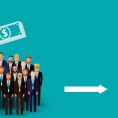Never underestimate just how powerful a customer’s opinion can be, whether it’s negative or positive, as it relates to the level of customer service you provide. According to the Word of Mouth Marketing Association, the typical American mentions specific brand names 60 times per week in online and offline conversations. Even more surprising is that 54% of the driving force behind a purchasing decision can be attributed to the opinions of a purchaser’s friends or family. Need some proof on just how influential a customer’s thoughts can be? Here are five examples of how powerful your customers’ feedback can prove at swaying others’ opinions.
Amazon.com
Amazon’s consumer rating system has built an incredibly strong reputation with audiences. In fact, according to statistics in a recent Harris Poll Reputation Quotient Study, the business’ consumer rating system has shot up the ratings from 8th to 4th place in terms of brands that enjoy the best reputations amongst the US public. Even though some heavy hitters outrank it (ex: Apple, Google and Coca-Cola), Amazon ranked highest in the study for Emotional Appeal.
Why is buying from Amazon considered such an emotional experience? The answer lies in the huge amount of influence that everyday shoppers have. In addition to deciding on an overall rating to give a business, service or product on a five-star scale, customers can also comment on aspect of the purchase itself or sales process, from how accurate color descriptions are to how well service was handled and shipments were packaged.
As on other online marketplaces such as eBay or Apple’s App Store, smaller businesses that sell on Amazon rely on customer feedback to let the broader public community know that they’re a reliable seller who stands by their products. Since most buyers will shy away from doing business from those with lower ratings or negative comments associated with their products or profiles, happy customers are crucial to conducting business. In fact, if a seller receives too many negative comments or low ratings, buyers will be leery about purchasing from them.
Carnival Cruise Lines
There’s been more than one recent headline on the trouble faced by Carnival cruise ships. The customers aboard the stranded Carnival Triumph all but single-handedly transformed public perceptions of the brand from one of the most economical and family-friendly cruising options to one that is ill-prepared for disaster and sports faulty maintenance programs in days flat. Descriptions of the disaster and ensuing onboard conditions was all that was necessary to create a complete shift in public opinion.
The big question many marketers are asking is “how will these opinions affect Carnival’s brand and ultimately, their business?” In tumultuous times like these where eyes are honed in on every little detail of a Carnival Cruise experience, it’s easy for consumers to spread more negative information than positive on travel forums, social networks, and similar channels.
Zappos
Incredible customer service is at the core of the company that’s grown to be the largest online shoe store since its founding in 1999. Consumers love to share their tales online on Twitter and Facebook of how Zappos has gone above and way, way beyond in helping them stay satisfied.
For example, one story involves a traveler checking into a Las Vegas hotel and forgetting her favorite pair of Zappos shoes. When she couldn’t find a similar pair on their website, she placed a call to the company’s help-desk concierge service. While they no longer carried the shoes, the Zappos team located a pair at a nearby mall, purchased them and hand-delivered them to the woman’s hotel – all free of charge.
Business Insider published more customer stories consisting of Zappos sending flowers to a woman who had to order several pairs of new shoes as a result of a medical condition, and overnighting a free pair of shoes to a best man whose shoes for the wedding got lost by an airline. Stories like these give Zappos an unbeatable reputation and result in ecstatic customers who enjoy telling everyone who’s looking to buy shoes about their fantastic experiences.
Domino’s Pizza
In 2009, two employees videotaped themselves engaging in some unappetizing, food-related actions and posted the clip on YouTube. Within 24 hours, the video went viral, achieving hundreds of thousands of views and receiving coverage from news media outlets that only drove more attention to the clip. This video prompted hundreds of other customers to speak up and share their own horror stories concerning experiences with Domino’s and its food. (Although, in fairness, we’ve generally enjoyed solid service and value from the company whenever a craving for pepperoni strikes.)
This negative backlash to Domino’s reputation for customer service and food quality helped launched an entire Domino’s rebranding in 2010, where the company whole-heartedly committed to turning a below-average product into something that more appealing to taste buds. The campaign was a huge success, resulting in twice as much annual revenue for the business.
The Pokémon Company
Piggybacking on a child’s natural instinct to collect things, compete against other kids, gain power and hone skills, the Pokémon brand has relied on children as consumers to secure its success. In its 15-year history, Pokémon has sold far more than 200 million video games, making it the world’s biggest gaming franchise. An engaged fan base stays committed to creating new content for the franchise, expanding on featured ideas and keeping others interested even when there isn’t necessarily a new product launch on the horizon. Without customers creating this user-generated material, the Pokémon brand wouldn’t be nearly as successful as it is, or still continue to draw in new fans around the world. Its massive fan base has helped lead to TV spinoffs, movies, toys, card games and much more.
Important to note here: Your organization doesn’t have to be as large as Amazon, or as well-funded as The Pokémon Company, to get customers raving about the level of service it provides. What does have to happen is a company-wide internal commitment to serving customers as well and swiftly as possible, and a system for doing so worked out in such a way that’s it’s consistently executable on a day-to-day basis. As a rule of thumb, a great way to accomplish this goal is to make sure that the customer is satisfied before, during, and after doing business with your brand.
Never underestimate just how powerful a customer’s opinion can be, whether it’s negative or positive. According to the Word of Mouth Marketing Association, the typical American mentions specific brand names 60 times per week in online and offline conversations. Even more surprising is that 54% of the driving force behind a purchasing decision can be attributed to the opinions of a purchaser’s friends or family. Need some proof on just how influential a customer’s thoughts can be? Here are five examples of how powerful your customers’ feedback can prove at swaying others’ opinions.
Amazon.com
Amazon’s consumer rating system has built an incredibly strong reputation with audiences. In fact, according to statistics in a recent Harris Poll Reputation Quotient Study, the business’ consumer rating system has shot up the ratings from 8th to 4th place in terms of brands that enjoy the best reputations amongst the US public. Even though some heavy hitters outrank it (ex: Apple, Google and Coca-Cola), Amazon ranked highest in the study for Emotional Appeal.
Why is buying from Amazon considered such an emotional experience? The answer lies in the huge amount of influence that everyday shoppers have. In addition to deciding on an overall rating to give a business, service or product on a five-star scale, customers can also comment on aspect of the purchase itself or sales process, from how accurate color descriptions are to how well service was handled and shipments were packaged.
As on other online marketplaces such as eBay or Apple’s App Store, smaller businesses that sell on Amazon rely on customer feedback to let the broader public community know that they’re a reliable seller who stands by their products. Since most buyers will shy away from doing business from those with lower ratings or negative comments associated with their products or profiles, happy customers are crucial to conducting business. In fact, if a seller receives too many negative comments or low ratings, buyers will be leery about purchasing from them.
Carnival Cruise Lines
There’s been more than one recent headline on the trouble faced by Carnival cruise ships. The customers aboard the stranded Carnival Triumph all but single-handedly transformed public perceptions of the brand from one of the most economical and family-friendly cruising options to one that is ill-prepared for disaster and sports faulty maintenance programs in days flat. Descriptions of the disaster and ensuing onboard conditions was all that was necessary to create a complete shift in public opinion.
The big question many marketers are asking is “how will these opinions affect Carnival’s brand and ultimately, their business?” In tumultuous times like these where eyes are honed in on every little detail of a Carnival Cruise experience, it’s easy for consumers to spread more negative information than positive on travel forums, social networks, and similar channels.
Zappos
Incredible customer service is at the core of the company that’s grown to be the largest online shoe store since its founding in 1999. Consumers love to share their tales online on Twitter and Facebook of how Zappos has gone above and way, way beyond in helping them stay satisfied.
For example, one story involves a traveler checking into a Las Vegas hotel and forgetting her favorite pair of Zappos shoes. When she couldn’t find a similar pair on their website, she placed a call to the company’s help-desk concierge service. While they no longer carried the shoes, the Zappos team located a pair at a nearby mall, purchased them and hand-delivered them to the woman’s hotel – all free of charge.
Business Insider published more customer stories consisting of Zappos sending flowers to a woman who had to order several pairs of new shoes as a result of a medical condition, and overnighting a free pair of shoes to a best man whose shoes for the wedding got lost by an airline. Stories like these give Zappos an unbeatable reputation and result in ecstatic customers who enjoy telling everyone who’s looking to buy shoes about their fantastic experiences.
Domino’s Pizza
In 2009, two employees videotaped themselves engaging in some unappetizing, food-related actions and posted the clip on YouTube. Within 24 hours, the video went viral, achieving hundreds of thousands of views and receiving coverage from news media outlets that only drove more attention to the clip. This video prompted hundreds of other customers to speak up and share their own horror stories concerning experiences with Domino’s and its food. (Although, in fairness, we’ve generally enjoyed solid service and value from the company whenever a craving for pepperoni strikes.)
This negative backlash to Domino’s reputation for customer service and food quality helped launched an entire Domino’s rebranding in 2010, where the company whole-heartedly committed to turning a below-average product into something that more appealing to taste buds. The campaign was a huge success, resulting in twice as much annual revenue for the business.
The Pokémon Company
Capitalizing on a child’s natural instinct to collect things, compete against other kids, gain power and hone skills, the Pokémon brand has relied on children as consumers to secure its success. In its 15-year history, Pokémon has sold far more than 200 million video games, making it the world’s biggest gaming franchise. An engaged fan base stays committed to creating new content for the franchise, expanding on featured ideas and keeping others interested even when there isn’t necessarily a new product launch on the horizon. Without customers creating this user-generated material, the Pokémon brand wouldn’t be nearly as successful as it is, or still continue to draw in new fans around the world. Its massive fan base has helped lead to TV spinoffs, movies, toys, card games and much more.
Important to note here: Your organization doesn’t have to be as large as Amazon, or as well-funded as The Pokémon Company, to get customers raving about the level of service it provides. What does have to happen is a company-wide internal commitment to serving customers as well and swiftly as possible, and a system for doing so worked out in such a way that’s it’s consistently executable on a day-to-day basis. As a rule of thumb, a great way to accomplish this goal is to make sure that the customer is satisfied before, during, and after doing business with your brand.














